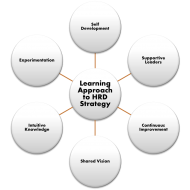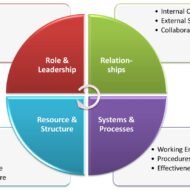Posted by Managementguru in Human Resource, Organisational behaviour, Principles of Management, Strategy
on May 24th, 2014 | 0 comments

What are Learning Organizations? Need for Learning Organizations: The ever evolving, dynamic business environment and the complex relationship among various countries in the political and business arena necessitate the need for a learning organization. This becomes essential for organizations to be flexible and be able to respond to change which is the only enduring source of competitive strength. What is a learning organization? A learning organization is the term given to a company that facilitates the learning of its members and continuously transforms itself. Learning organizations develop as a result of the pressures facing modern organizations and enables them to remain competitive in the business environment. Learning is used to reach their goals and avoid repeating mistakes. Employees learn to link their personal goals to organizational goals and link rewards to key measures of performance. The managers learn to design systems and procedures to motivate learning process and to encourage employees to feel free to share information and take risks. Characteristics of a learning organization: It nurtures a climate of trust in the organization and people are encouraged to learn and develop their #knowledge and skill sets. It inspires human resources in the immediate external environment such as customers, suppliers, creditors etc., to learn as and when possible. The whole business policy revolves around #HRD strategy. The organization subjects itself to continuous transformation in which learning and working run hand-in-hand. Learning Based Techniques: Organizational learning concept is the latest OD (#Organizational Development) technique. #Ernst & Young, the largest #accounting firm has set the following procedures for learning purpose. Managers play a vital role in this transformational process of learning. They are responsible for choosing employees who are willing to and capable of learning, and must ensure that the participants in the program are trainable. They must get the support of #trainees and others. Trainees must be appraised about the benefits that will result from training and the managers also should enjoy the support of supervisors, #co-workers and their sub-ordinates. This is very essential to facilitate learning process, to ensure availing of honor and respect of peers and sub-ordinates. The opinion of trainees, supervisors, co-workers and sub-ordinates must be obtained on the content of training, the location and the time and duration of the training. Managers also play a key role in assisting others in goal-setting and meeting those goals. Goal setting is necessary to improve their performance and direct their attention to specific #behavior that needs to be changed. Managers may assist the sub-ordinates and peers to identify tools and resources for acquiring knowledge. Managers must also focus on providing performance feedback as it serves two objectives; it provides information on performance and serves as a motivating tool. Managers should urge their employees to analyze their performance, identify weaknesses and take action to overcome weaknesses. Managers may assist the employee to transfer the learned skills/knowledge to work. It will be a wiser move to design #training methods in such a way as to enable the trainees to practice skills on their jobs between training sessions. DOWNLOAD THE PDF VERSION...

Posted by Managementguru in Decision Making, Human Resource, Organisational behaviour, Principles of Management, Training & Development
on Mar 19th, 2014 | 0 comments

How to Grade Your Employees on Their Performance Performance appraisal is the process of obtaining, analyzing and recording information about the relative worth of an employee. Organizational Development: Organizational Development denotes an overall and comprehensive development of an organization supported by the entire team of employees working for that organization. A useful technique in the management process that serves as a measure of performance and productivity is “performance evaluation” or performance appraisal. Performance refers to the degree of accomplishment of the task that makes up an individual’s job. Performance appraisal serves the following purpose: To assess the present levels of employee performance. To understand the future needs in training and development based on the strengths and weaknesses of the employees. To provide feedback on their performance. Serves as a basis for reward allocation, such as, increase in pay scale, promotions and many other decisions like, confirmations, transfer, demotion etc. , Establishes performance standards and offers scope for improvement. Acts as a motivational tool for workers to perform better. Checks and facilitates employees who exhibit poor performance. Also assesses behavioral pattern of the employees. People who work for big corporate companies identify themselves with the objectives of the company and expect feedback, either in the form of a compliment or criticism. Compliments act as morale boosters to perform better and criticism though initially might puncture the ego, induces the potential to perform, to prove oneself. Managers should never be reluctant on their part to appraise subordinates on the job expectations and demands. In an activity as important as managing, there must be no pitfalls to measure performance as accurately as possible. The Appraisal Process: The next important aspect in the appraisal process would be deciding the content to be appraised. Individual task outcomes where performance is evaluated on the outcomes delivered by the individuals, evaluation of personal characteristics and traits or behavior are done to rate the employees as to where they stand in terms of performance. Appraisal Techniques: The widely used managerial technique in the appraisal process is evaluating performance against verifiable objectives, which truly makes sense, because the employees would be blind folded if they don’t have the right direction to proceed. Evaluation can be done in a comprehensive, periodic or continuous fashion. It all depends on the nature of work done, company practice and other situational factors. Say, for instance, performance review can be done after the completion of a major project, that makes sense, doesn’t it? Periodical reviews: Formal reviews can be supplemented and supported with frequent and short informal reviews, for the superior- subordinate relationship to prosper and to keep communication channels open. All said and done, performance review based on verifiable objectives, although gives better vision and clarity, doesn’t allow the manager or subordinate to grow individually. It does not help in personality development, the emphasis ever being focused on accomplishing the operating objectives. The 360 Degree Apparaisal: The latest approach of performance evaluation is the 360 degree appraisal that well suits the managerial cadre. It provides for performance feedback from the full circle of daily contact, that a manager might have, ranging from customers, peers, subordinates, boss etc. , This also fits into organizations that have introduced teams, employee participation and total quality management...

Posted by Managementguru in Organisational behaviour, Principles of Management
on Feb 22nd, 2014 | 0 comments

Organizational change is concerned with making things different and change agent is a person or group of persons who act as catalysts to bring about change. Say, managers and outside expert consultants can be called as change agents. What is Organizational Change? This is how you have to Strategise in order to Win Organizational development refers to the overall development of an organization in terms of improving the ability of that organization in tandem with the needs of the external environment and involves a system oriented approach to change. Recommended: Resourceful Guide on Organizational Development from Maryville University titled ” Organizational Development Guide: Definition, Process & Development Models “ Organizational change: All the elements of a social system like people, formal organization, informal organization, operational environment, communication, decision making and patterns of co-operation are bound to change when there is change in the external environment but this gives rise to a positive pressure which acts like a self-correcting mechanism to modify and set right the bottle-necks or loop-holes in the working system. Causes For Change Work force: The increasing awareness and educational qualification among the workforce is responsible for the attitude change. You can expect loyalty from workers above fifty but not workers who fall under the age category thirty. This is because their loyalty is oriented towards their career and not to the employer. Technology change: Internet, telecommunication systems, computers, robotics, flexible manufacturing operations have created a great impact on the working style of firms and necessitated the work force to be tech-savvy in order to survive in the job market. Economic, social, political, and physical environmental changes: Economic– Business cycles, inflation, recession, stock market crashSocial– Changing life styles and preferences of customers is the keyPhysical– Consumers, suppliers, employees, union, shareholders and the governmentPolitical– Political decisions affecting the market, pressure, legal hassles:- all these affect the working of a firm. Changes in competition: Global economy has brought big players from countries like USA, Japan, Germany and the like to compete in the same market and successful organizational are those who have adapted to competitive environment. When we talk about organizational change, we emphasize on “PLANNED CHANGE OR DELIBERATE CHANGE” in order to suit ourselves to the changing environment. Otherwise, according to Darwin’s theory of “Survival of the fittest” you will fade away in due course of evolution. This Infographic clearly reveals the fact that “It is not the strongest of the species that survive, nor the most intelligent, but the one most responsive to...






